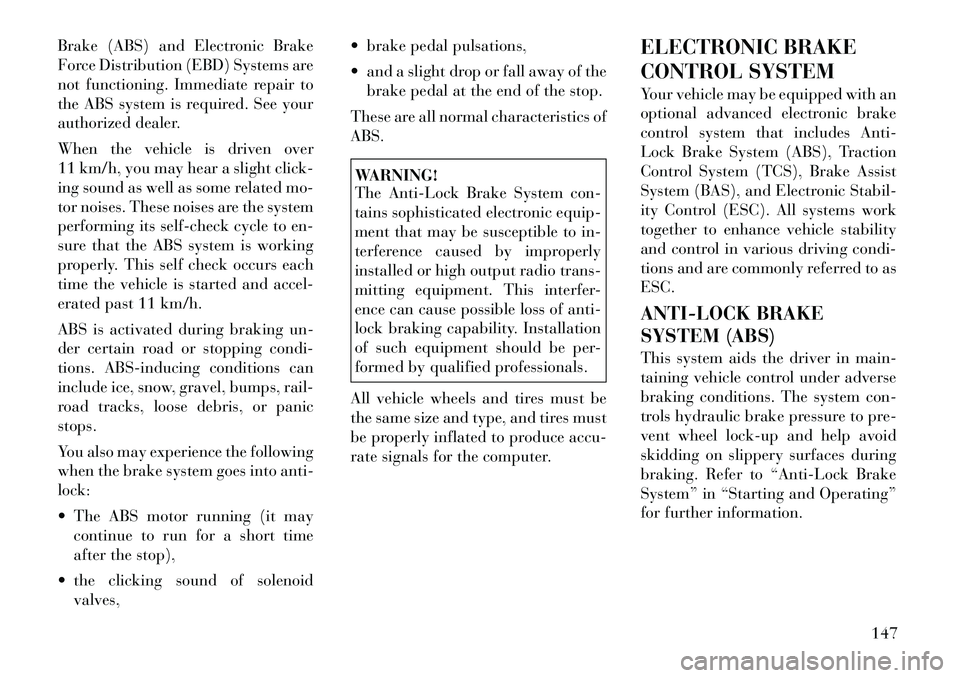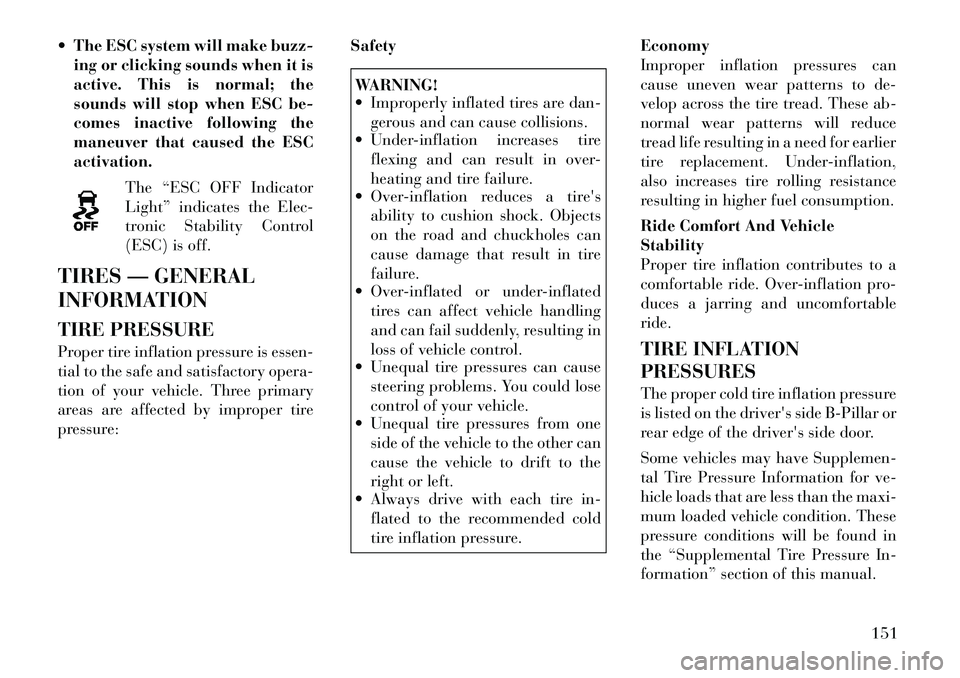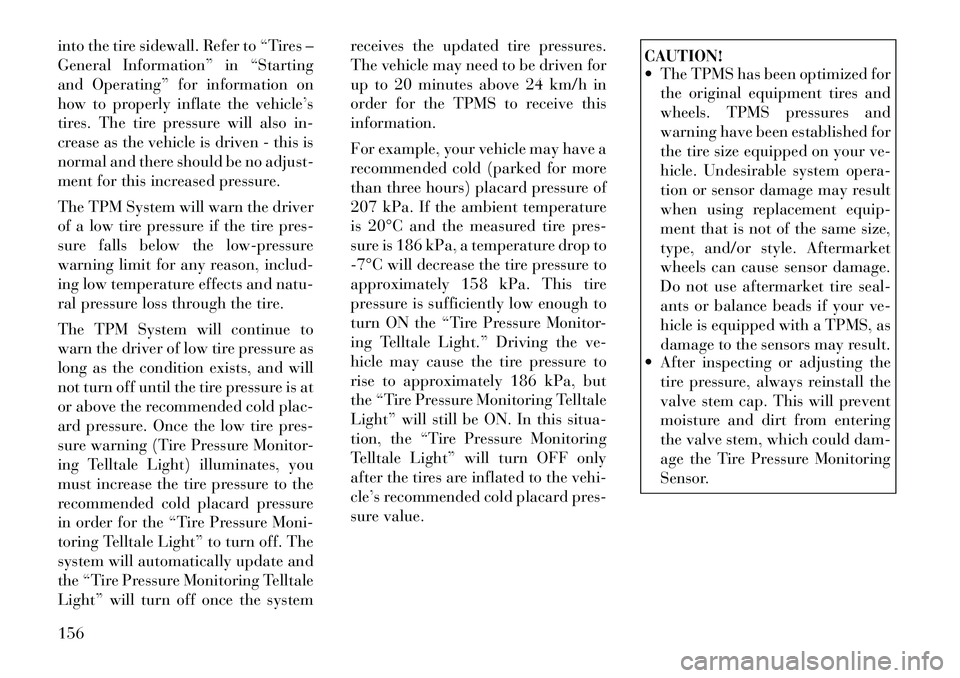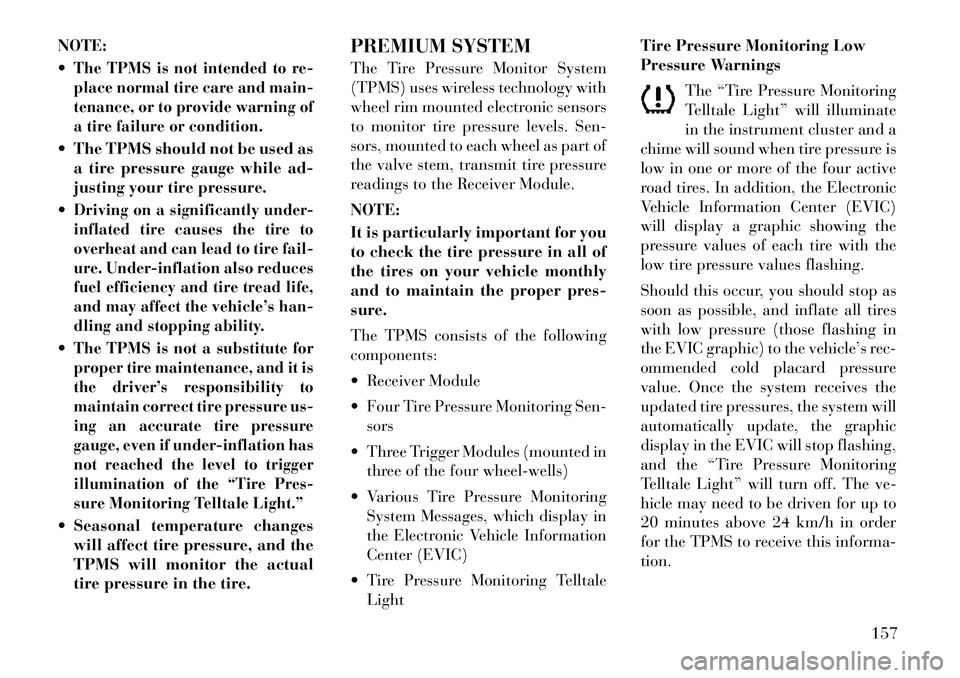light Lancia Flavia 2012 Owner handbook (in English)
[x] Cancel search | Manufacturer: LANCIA, Model Year: 2012, Model line: Flavia, Model: Lancia Flavia 2012Pages: 233, PDF Size: 2.61 MB
Page 152 of 233

PARKING BRAKE
Before leaving the vehicle, make sure
that the parking brake is fully ap-
plied. Also, be certain to leave the
transmission in PARK.
The parking brake lever is located in
the center console. To apply the park-
ing brake, pull the lever up as firmly
as possible. To release the parking
brake, pull the lever up slightly, press
the center button, then lower the lever
completely.
When the parking brake is applied
with the ignition switch ON, the
“Brake Warning Light” in the instru-
ment cluster will illuminate.NOTE:
When the parking brake is ap-
plied and the transmission is
placed in gear, the “Brake Warn-
ing Light” will flash. If vehicle
speed is detected, a chime will
sound to alert the driver. Fully
release the parking brake before
attempting to move the vehicle.
This light only shows that the parking brake is applied. It does
not show the degree of brake ap-
plication.
When parking on a hill, it is important
to turn the front wheels toward the
curb on a downhill grade and away
from the curb on an uphill grade.
Apply the parking brake before plac-
ing the shift lever in PARK, otherwise
the load on the transmission locking
mechanism may make it difficult to
move the shift lever out of PARK. The
parking brake should always be ap-
plied whenever the driver is not in the
vehicle.
WARNING!
Never use the PARK position as a substitute for the parking brake.
Always apply the parking brake
fully when parked to guard
against vehicle movement and
possible injury or damage.
When leaving the vehicle, always
remove the key fob from the igni-
tion and lock your vehicle.
Never leave children alone in a
vehicle, or with access to an un-
locked vehicle. Allowing children
to be in a vehicle unattended is
dangerous for a number of rea-
sons. A child or others could be
seriously or fatally injured. Chil-
dren should be warned not to
touch the parking brake, brake
pedal or the shift lever.
Do not leave the key fob in or near
the vehicle. A child could operate
power windows, other controls, or
move the vehicle.
Be sure the parking brake is fully
disengaged before driving; failure
to do so can lead to brake failure
and a collision.
(Continued)
Parking Brake
145
Page 153 of 233

WARNING!(Continued)
Always fully apply the parking
brake when leaving your vehicle
or it may roll and cause damage or
injury. Also, be certain to leave the
transmission in PARK. Failure to
do so may cause the vehicle to roll
and cause damage or injury.CAUTION!
If the “Brake Warning Light” re-
mains on with the parking brake
released, a brake system malfunc-
tion is indicated. Have the brake
system serviced by an authorized
dealer immediately.
ANTI-LOCK BRAKE
SYSTEM (ABS)
The Anti-Lock Brake System (ABS)
provides increased vehicle stability
and brake performance under most
braking conditions. The system oper-
ates with a separate computer to
modulate the hydraulic pressure to
prevent wheel lock-up and avoid
skidding on slippery surfaces.
WARNING!
Pumping of the anti-lock brakes will diminish their effectiveness
and may lead to a collision.
Pumping makes the stopping dis-
tance longer. Just press firmly on
your brake pedal when you need
to slow down or stop.
The ABS cannot prevent the natu-
ral laws of physics from acting on
the vehicle, nor can it increase
braking or steering efficiency be-
yond that afforded by the condi-
tion of the vehicle brakes and tires
or the traction afforded.
The ABS cannot prevent colli-
sions, including those resulting
from excessive speed in turns, fol-
lowing another vehicle too closely,
or hydroplaning.
The capabilities of an ABS-
equipped vehicle must never be
exploited in a reckless or danger-
ous manner, which could jeopar-
dize the user's safety or the safety
of others. The
“Anti-Lock Brake
Warning Light” monitors
the Anti-Lock Brake Sys-
tem. The light will come on
when the ignition switch is turned to
the ON position and may stay on for
as long as four seconds.
If the “Anti-Lock Brake Warning
Light” remains on or comes on while
driving, it indicates that the anti-lock
portion of the brake system is not
functioning and that service is re-
quired. However, the conventional
brake system will continue to operate
normally if the “Brake Warning
Light” is not on.
If the “Anti-Lock Brake Warning
Light” is on, the brake system should
be serviced as soon as possible to re-
store the benefits of anti-lock brakes.
If the “Anti-Lock Brake Warning
Light” does not come on when the
ignition switch is turned to the ON
position, have the bulb repaired as
soon as possible.
If both the “Brake Warning Light”
and the “Anti-Lock Brake Warning
Light” remain on, the Anti-Lock
146
Page 154 of 233

Brake (ABS) and Electronic Brake
Force Distribution (EBD) Systems are
not functioning. Immediate repair to
the ABS system is required. See your
authorized dealer.
When the vehicle is driven over
11 km/h, you may hear a slight click-
ing sound as well as some related mo-
tor noises. These noises are the system
performing its self-check cycle to en-
sure that the ABS system is working
properly. This self check occurs each
time the vehicle is started and accel-
erated past 11 km/h.
ABS is activated during braking un-
der certain road or stopping condi-
tions. ABS-inducing conditions can
include ice, snow, gravel, bumps, rail-
road tracks, loose debris, or panic
stops.
You also may experience the following
when the brake system goes into anti-
lock:
The ABS motor running (it maycontinue to run for a short time
after the stop),
the clicking sound of solenoid valves, brake pedal pulsations,
and a slight drop or fall away of the
brake pedal at the end of the stop.
These are all normal characteristics of
ABS.
WARNING!
The Anti-Lock Brake System con-
tains sophisticated electronic equip-
ment that may be susceptible to in-
terference caused by improperly
installed or high output radio trans-
mitting equipment. This interfer-
ence can cause possible loss of anti-
lock braking capability. Installation
of such equipment should be per-
formed by qualified professionals.
All vehicle wheels and tires must be
the same size and type, and tires must
be properly inflated to produce accu-
rate signals for the computer. ELECTRONIC BRAKE
CONTROL SYSTEM
Your vehicle may be equipped with an
optional advanced electronic brake
control system that includes Anti-
Lock Brake System (ABS), Traction
Control System (TCS), Brake Assist
System (BAS), and Electronic Stabil-
ity Control (ESC). All systems work
together to enhance vehicle stability
and control in various driving condi-
tions and are commonly referred to as
ESC.
ANTI-LOCK BRAKE
SYSTEM (ABS)
This system aids the driver in main-
taining vehicle control under adverse
braking conditions. The system con-
trols hydraulic brake pressure to pre-
vent wheel lock-up and help avoid
skidding on slippery surfaces during
braking. Refer to “Anti-Lock Brake
System” in “Starting and Operating”
for further information.
147
Page 156 of 233

ELECTRONIC STABILITY
CONTROL (ESC)
This system enhances directional con-
trol and stability of the vehicle under
various driving conditions. ESC cor-
rects for over/under steering of the
vehicle by applying the brake of the
appropriate wheel to assist in counter-
acting the over/under steer condition.
Engine power may also be reduced to
help the vehicle maintain the desired
path. ESC uses sensors in the vehicle
to determine the vehicle path in-
tended by the driver and compares it
to the actual path of the vehicle. When
the actual path does not match the
intended path, ESC applies the brake
of the appropriate wheel to assist in
counteracting the oversteer or under-
steer condition.
Over-steer - when the vehicle isturning more than appropriate for
the steering wheel position.
Under-steer - when the vehicle is turning less than appropriate for
the steering wheel position.
WARNING!
The Electronic Stability Control
(ESC) cannot prevent the natural
laws of physics from acting on the
vehicle, nor can it increase the trac-
tion afforded by prevailing road
conditions. ESC cannot prevent ac-
cidents, including those resulting
from excessive speed in turns, driv-
ing on very slippery surfaces, or hy-
droplaning. ESC also cannot pre-
vent accidents resulting from loss of
vehicle control due to inappropriate
driver input for the conditions. Only
a safe, attentive, and skillful driver
can prevent accidents. The capabili-
ties of an ESC equipped vehicle
must never be exploited in a reckless
or dangerous manner which could
jeopardize the user’s safety or the
safety of others. ESC Operating Modes
All ESC equipped vehicles can choose
the following ESC operating modes:
ESC On
This is the normal operating mode for
ESC. Whenever the vehicle is started
the ESC system will be in this mode.
This mode should be used for almost
all driving situations. ESC should
only be turned to “Partial Off” for
specific reasons as noted below.
Partial ESC Mode
This mode is entered by momentarily
pressing the “ESC Off” switch (lo-
cated in the lower switch bank below
the heater/air conditioning controls).
When in “Partial Off” mode, the TCS
portion of ESC, except for the limited
slip feature described in the TCS sec-
tion, has been disabled and the “ESC
Activation/Malfunction Indicator
Light” will be illuminated. All other
stability features of ESC function nor-
mally, with the exception of engine
power reduction. This mode is in-
tended to be used if the vehicle is in
deep snow, sand, or gravel conditions
149
Page 157 of 233

and more wheel spin than ESC would
normally allow is required to gain
traction.
To turn ESC on again, momentarily
press the “ESC Off” switch. This will
restore the normal “ESC On” mode of
operation.WARNING!
In partial ESC mode, the engine
power reduction feature of ESC is
disabled. Therefore, enhanced ve-
hicle stability offered by the ESC
system is reduced.
NOTE:
To improve the vehicle's traction
when driving with snow chains, or
starting off in deep snow, sand or
gravel, it may be desirable to switch to the “Partial Off” mode by
pressing the “ESC Off” switch.
Once the situation requiring ESC
to be switched to the “Partial Off”
mode is overcome, turn ESC on
again by momentarily pressing the
“ESC Off” switch. This may be
done while the vehicle is in mo-
tion.
ESC ACTIVATION/
MALFUNCTION
INDICATOR LIGHT AND
ESC OFF INDICATOR
LIGHT
The “ESC Activation/Mal-
function Indicator Light” in
the instrument cluster will
come on when the ignition
switch is turned to the ON position. It
should go out with the engine running.
If the “ESC Activation/Malfunction In-
dicator Light” comes on continuously
with the engine running, a malfunction
has been detected in the ESC system. If
this light remains on after several igni-
tion cycles, and the vehicle has been
driven several miles (kilometers) at
speeds greater than 48 km/h, see your authorized dealer as soon as possible to
have the problem diagnosed and cor-
rected.
The “ESC Activation/Malfunction In-
dicator Light” (located in the instru-
ment cluster) starts to flash as soon as
the tires lose traction and the ESC
system becomes active. The “ESC
Activation/Malfunction Indicator
Light” also flashes when TCS is ac-
tive. If the “ESC Activation/
Malfunction Indicator Light” begins
to flash during acceleration, ease up
on the accelerator and apply as little
throttle as possible. Be sure to adapt
your speed and driving to the prevail-
ing road conditions.
NOTE:
The “ESC Activation/Malfunc-
tion Indicator Light” and the
“ESC OFF Indicator Light” come
on momentarily each time the ig-
nition switch is turned ON. Each time the ignition is turned
ON, the ESC system will be ON
even if it was turned off previ-
ously.
ESC Off Switch
150
Page 158 of 233

The ESC system will make buzz-ing or clicking sounds when it is
active. This is normal; the
sounds will stop when ESC be-
comes inactive following the
maneuver that caused the ESC
activation.
The “ESC OFF Indicator
Light” indicates the Elec-
tronic Stability Control
(ESC) is off.
TIRES — GENERAL
INFORMATION
TIRE PRESSURE
Proper tire inflation pressure is essen-
tial to the safe and satisfactory opera-
tion of your vehicle. Three primary
areas are affected by improper tire
pressure: Safety
WARNING!
Improperly inflated tires are dan-
gerous and can cause collisions.
Under-inflation increases tire
flexing and can result in over-
heating and tire failure.
Over-inflation reduces a tir e's
ability to cushion shock. Objects
on the road and chuckholes can
cause damage that result in tire
failure.
Over -inflated or under-inflated
tires can affect vehicle handling
and can fail suddenly, resulting in
loss of vehicle control.
Unequal tire pressures can cause
steering problems. You could lose
control of your vehicle.
Unequal tire pressures from one
side of the vehicle to the other can
cause the vehicle to drift to the
right or left.
Always drive with each tire in-
flated to the recommended cold
tire inflation pressure. Economy
Improper inflation pressures can
cause uneven wear patterns to de-
velop across the tire tread. These ab-
normal wear patterns will reduce
tread life resulting in a need for earlier
tire replacement. Under-inflation,
also increases tire rolling resistance
resulting in higher fuel consumption.
Ride Comfort And Vehicle
Stability
Proper tire inflation contributes to a
comfortable ride. Over-inflation pro-
duces a jarring and uncomfortable
ride.
TIRE INFLATION
PRESSURES
The proper cold tire inflation pressure
is listed on the
driver's sideB-Pillar or
rear edge of the driver's side door.
Some vehicles may have Supplemen-
tal Tire Pressure Information for ve-
hicle loads that are less than the maxi-
mum loaded vehicle condition. These
pressure conditions will be found in
the “Supplemental Tire Pressure In-
formation” section of this manual.
151
Page 160 of 233

Cuts and punctures in radial tires are
repairable only in the tread area be-
cause of sidewall flexing. Consult
your authorized tire dealer for radial
tire repairs.
TIRE SPINNING
When stuck in mud, sand, snow, or icy
conditions, do not spin yourvehicle's
wheels faster than 48 km/h or for
longer than 30 seconds continuously
without stopping.
Refer to “Freeing A Stuck Vehicle” in
“What To Do In Emergencies” for fur -
ther information.WARNING!
Fast spinning tires can be danger-
ous. Forces generated by excessive
wheel speeds may cause tire damage
or failure. A tire could explode and
injure someone. Do not spin your
vehicle's wheels faster than 48 km/h
or for more than 30 seconds con-
tinuously when you are stuck, and
do not let anyone near a spinning
wheel, no matter what the speed. TREAD WEAR
INDICATORS
Tread wear indicators are in the origi-
nal equipment tires to help you in
determining when your tires should
be replaced.
These indicators are molded into the
bottom of the tread grooves. They will
appear as bands when the tread depth
becomes 2 mm. When the tread is
worn to the tread wear indicators, the
tire should be replaced.
LIFE OF TIRE
The service life of a tire is dependent
upon varying factors including but
not limited to:
Driving style
Tire pressure
Distance driven
WARNING!
Tires and spare tire should be re-
placed after six years, regardless of
the remaining tread. Failure to fol-
low this warning can result in sud-
den tire failure. You could lose con-
trol and have a collision resulting in
serious injury or death.
Keep dismounted tires in a cool, dry
place with as little exposure to light as
possible. Protect tires from contact
with oil, grease, and gasoline.
1 — Worn Tire
2 — New Tire
153
Page 163 of 233

into the tire sidewall. Refer to “Tires –
General Information” in “Starting
and Operating” for information on
how to properly inflate the vehicle’s
tires. The tire pressure will also in-
crease as the vehicle is driven - this is
normal and there should be no adjust-
ment for this increased pressure.
The TPM System will warn the driver
of a low tire pressure if the tire pres-
sure falls below the low-pressure
warning limit for any reason, includ-
ing low temperature effects and natu-
ral pressure loss through the tire.
The TPM System will continue to
warn the driver of low tire pressure as
long as the condition exists, and will
not turn off until the tire pressure is at
or above the recommended cold plac-
ard pressure. Once the low tire pres-
sure warning (Tire Pressure Monitor-
ing Telltale Light) illuminates, you
must increase the tire pressure to the
recommended cold placard pressure
in order for the “Tire Pressure Moni-
toring Telltale Light” to turn off. The
system will automatically update and
the “Tire Pressure Monitoring Telltale
Light” will turn off once the systemreceives the updated tire pressures.
The vehicle may need to be driven for
up to 20 minutes above 24 km/h in
order for the TPMS to receive this
information.
For example, your vehicle may have a
recommended cold (parked for more
than three hours) placard pressure of
207 kPa. If the ambient temperature
is 20°C and the measured tire pres-
sure is 186 kPa, a temperature drop to
7°C will decrease the tire pressure to
approximately 158 kPa. This tire
pressure is sufficiently low enough to
turn ON the “Tire Pressure Monitor-
ing Telltale Light.” Driving the ve-
hicle may cause the tire pressure to
rise to approximately 186 kPa, but
the “Tire Pressure Monitoring Telltale
Light” will still be ON. In this situa-
tion, the “Tire Pressure Monitoring
Telltale Light” will turn OFF only
after the tires are inflated to the vehi-
cle’s recommended cold placard pres-
sure value.
CAUTION!
The TPMS has been optimized for
the original equipment tires and
wheels. TPMS pressures and
warning have been established for
the tire size equipped on your ve-
hicle. Undesirable system opera-
tion or sensor damage may result
when using replacement equip-
ment that is not of the same size,
type, and/or style. Aftermarket
wheels can cause sensor damage.
Do not use aftermarket tire seal-
ants or balance beads if your ve-
hicle is equipped with a TPMS, as
damage to the sensors may result.
After inspecting or adjusting the
tire pressure, always reinstall the
valve stem cap. This will prevent
moisture and dirt from entering
the valve stem, which could dam-
age the Tire Pressure Monitoring
Sensor.
156
Page 164 of 233

NOTE:
The TPMS is not intended to re-
place normal tire care and main-
tenance, or to provide warning of
a tire failure or condition. The TPMS should not be used asa tire pressure gauge while ad-
justing your tire pressure.
Driving on a significantly under-
inflated tire causes the tire to
overheat and can lead to tire fail-
ure. Under-inflation also reduces
fuel efficiency and tire tread life,
and may affect the vehicle’s han-
dling and stopping ability.The TPMS is not a substitute for
proper tire maintenance, and it is
the driver’s responsibility to
maintain correct tire pressure us-
ing an accurate tire pressure
gauge, even if under-inflation has
not reached the level to trigger
illumination of the “Tire Pres-
sure Monitoring Telltale Light.” Seasonal temperature changes will affect tire pressure, and the
TPMS will monitor the actual
tire pressure in the tire. PREMIUM SYSTEM
The Tire Pressure Monitor System
(TPMS) uses wireless technology with
wheel rim mounted electronic sensors
to monitor tire pressure levels. Sen-
sors, mounted to each wheel as part of
the valve stem, transmit tire pressure
readings to the Receiver Module.
NOTE:
It is particularly important for you
to check the tire pressure in all of
the tires on your vehicle monthly
and to maintain the proper pres-
sure.
The TPMS consists of the following
components:
Receiver Module
Four Tire Pressure Monitoring Sen-
sors
Three Trigger Modules (mounted in three of the four wheel-wells)
Various Tire Pressure Monitoring System Messages, which display in
the Electronic Vehicle Information
Center (EVIC)
Tire Pressure Monitoring Telltale Light Tire Pressure Monitoring Low
Pressure Warnings
The “Tire Pressure Monitoring
Telltale Light” will illuminate
in the instrument cluster and a
chime will sound when tire pressure is
low in one or more of the four active
road tires. In addition, the Electronic
Vehicle Information Center (EVIC)
will display a graphic showing the
pressure values of each tire with the
low tire pressure values flashing.
Should this occur, you should stop as
soon as possible, and inflate all tires
with low pressure (those flashing in
the EVIC graphic) to the vehicle’s rec-
ommended cold placard pressure
value. Once the system receives the
updated tire pressures, the system will
automatically update, the graphic
display in the EVIC will stop flashing,
and the “Tire Pressure Monitoring
Telltale Light” will turn off. The ve-
hicle may need to be driven for up to
20 minutes above 24 km/h in order
for the TPMS to receive this informa-
tion.
157
Page 165 of 233

Check TPMS Warning
When a system fault is detected, a
chime will sound and the “Tire Pres-
sure Monitoring Telltale Light” will
flash on and off for 75 seconds and
then remain on solid. In addition, the
EVIC will display a "CHECK TPM
SYSTEM" message for a minimum of
five seconds and then display dashes
(- -) in place of the pressure value to
indicate which sensor is not being re-
ceived.
If the ignition key is cycled, this se-
quence will repeat, providing the sys-
tem fault still exists. If the system
fault no longer exists, the “Tire Pres-
sure Monitoring Telltale Light” will
no longer flash, and the "CHECK
TPM SYSTEM" message will no lon-
ger display, and a pressure value will
display in place of the dashes. A sys-
tem fault can occur due to any of the
following:
1. Jamming due to electronic devices
or driving next to facilities emitting
the same Radio Frequencies as the
TPM sensors.2. Installing some form of aftermar-
ket window tinting that affects radio
wave signals.
3. Lots of snow or ice around the
wheels or wheel housings.
4. Using tire chains on the vehicle.
5. Using wheels/tires not equipped
with TPM sensors.
The EVIC will also display a
"CHECK TPM SYSTEM" message
for a minimum of five seconds when a
system fault related to an incorrect
sensor location fault is detected. In
this case, the "CHECK TPM SYS-
TEM" message is then followed with a
graphic display with pressure values
still shown. This indicates that the
pressure values are still being received
from the TPM sensors but they may
not be located in the correct vehicle
position. The system still needs to be
serviced as long as the "CHECK TPM
SYSTEM" message is displayed.
FUEL REQUIREMENTS
All engines are designed to meet all
emissions regulations and provide ex-
cellent fuel economy and performance
when using high quality unleaded
gasoline with a minimum research oc-
tane rating of 91.
Light spark knock at low engine speeds
is not harmful to your engine. How-
ever, continued heavy spark knock at
high speeds can cause damage and im-
mediate service is required. Poor qual-
ity gasoline can cause problems such as
hard starting, stalling, and hesitations.
If you experience these symptoms, try
another brand of gasoline before con-
sidering service for the vehicle.Over 40 auto manufactur
er's world
wide have issued and endorsed con-
sistent gasoline specifications (the
Worldwide Fuel Charter, WWFC)
which define fuel properties necessary
to deliver enhanced emissions, perfor-
mance, and durability for your ve-
hicle. The manufacturer recommends
the use of gasoline that meets the
WWFC specifications if they are
available.
158